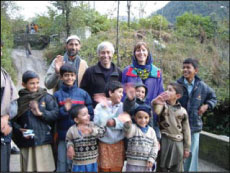Building Straw Bale
Homes in Quake-Devastated Pakistan
By Kamran Khan
 Architect
Martin Hammer with earthquake victims in Pakistan
Architect
Martin Hammer with earthquake victims in Pakistan |
Question: Mr. Hammer, what
is your professional background and what prompted you to
go to Pakistan to help with the earthquake relief efforts?
Answer: I am an architect who has been in private practice
for twenty years, designing mostly custom residential projects,
but occasionally small commercial or institutional projects
as well. I have been involved with the design, engineering,
and construction of straw bale buildings for 10 years. I
have written extensively about straw bale construction,
and have been involved with straw bale building codes for
the last 5 years, including writing a proposed straw bale
building code for the State of California. Last year a colleague,
a woman engineer who resides in Truckee, California named
Darcey Donovan, invited me to join her to continue her effort
to bring the method of straw bale construction to earthquake-affected
Pakistan, and I agreed.
Q: You and your colleague have proposed
building new homes with straw bale in the earthquake affected
areas in Pakistan. Isn’t that a rather antiquated
technology?
A: First, whether a building technology
has been available for 10 minutes or 10 thousand years isn’t
relevant. All that matters is that it works and is appropriate
for a given circumstance. Straw bale construction both works
and is very appropriate for the earthquake affected region
of Pakistan.
 Martin
Hammer
Martin
Hammer |
Q: Won’t
the straw bale homes be quite vulnerable to fire, rain,
and salination? What would happen if it rains during the
construction?
Loose straw is very flammable, baled straw is resistant
to fire, and a plastered straw bale wall is extremely resistant
to fire. So it is true that care must be taken to keep a
construction site clear of loose straw and free from ignition
sources. Moisture is a very important concern for straw
bale buildings. Straw, like wood, when it becomes wet and
stays wet (above 20% moisture content) will deteriorate.
However the same volume of straw deteriorates faster than
wood, mostly due to its lower density. So it’s important
to keep straw dry from the time it is cut in the field to
the time it is plastered, as well as during its life in
a building.
Q: How can those who might be skeptical
about straw bale construction method be made more confident
about the utility and reliability of this construction technique?
A: Overcoming unfamiliarity with straw
bale construction is one of the challenges we face in Pakistan.
This is often a problem in the United States and elsewhere
as well. We give presentations, and we encourage people
to read books and research relevant websites. Two of the
best ways to develop confidence in straw bale construction
are to participate in the construction of a straw bale building
oneself, or to visit a building already constructed. I’ve
heard people say once they’ve lived in a straw bale
house, they would never live in anything else.
Q: Will you be building these straw bale
homes or just educating interested groups and NGOs about
building such homes?
A: Our objective is to spread awareness
and capability for this method of construction as soon as
possible and to as broad a geographic area as possible.
We are building pilot projects, and at the same time training
students to build with this method, so they can build on
their own and train others as well. Our intent is not to
build for people, but to teach people to build for themselves.
We have partnered, and will continue to form new partnerships
with NGOs and other interested groups to conduct trainings
and educate people about straw bale construction. We wish
to make ourselves unnecessary as soon as we can.
Q: To the best of your knowledge, what
other technologies are being employed to rebuild quake damaged
homes? What are the comparative advantages of straw bale
homes?
Other technologies being used in the reconstruction include:
steel reinforced concrete block with light gauge steel roof
framing, wood reinforced stone masonry with wood framed
roof, reinforced concrete post and beam with reinforced
concrete block infill,
diagonally braced timber frame with stone and clay mortar
infill (called dhajji).
Advantages of straw bale construction for earthquake affected
Pakistan are as follows:
It is earthquake resistant, energy and resource efficient,
renewable and readily available, utilizes unskilled labor,
affordable, fire resistant, pest resistant, aesthetically
pleasing – traditional appearance, natural and non-tox.
The other technologies being used have some of the above
advantages, but none have all of them.
Q: You had
recently met with members of the Pakistan American Democratic
forum (PADF). How can organizations like PADF help you with
your project?
A: Organizations like PADF could help our
effort in two ways. One is to help spread awareness of our
effort, especially to Pakistani Americans and to Pakistanis
within Pakistan. The other is to help with fundraising.
Q:
How were you received in Pakistan and do you think your
trip was helpful in building people-to-people goodwill between
Pakistan and the United States?
As I mentioned earlier, one of the primary reasons I went
to Pakistan to do this work was to help establish “people-to-people”
goodwill between Pakistan and the United States. That kind
of direct goodwill is very important, and very different
from any relationship that exists between governments. It
is more genuine, and more human. It is always a good thing
to do between different cultures, but it is especially important
to do now, between the United States and a primarily Islamic
country such as Pakistan. Many misconceptions exist in both
countries about the other, largely due to partial views
or misrepresentations portrayed in various forms of the
news media.
* AMA Intern
-------------------------------------------------------------------------------------

